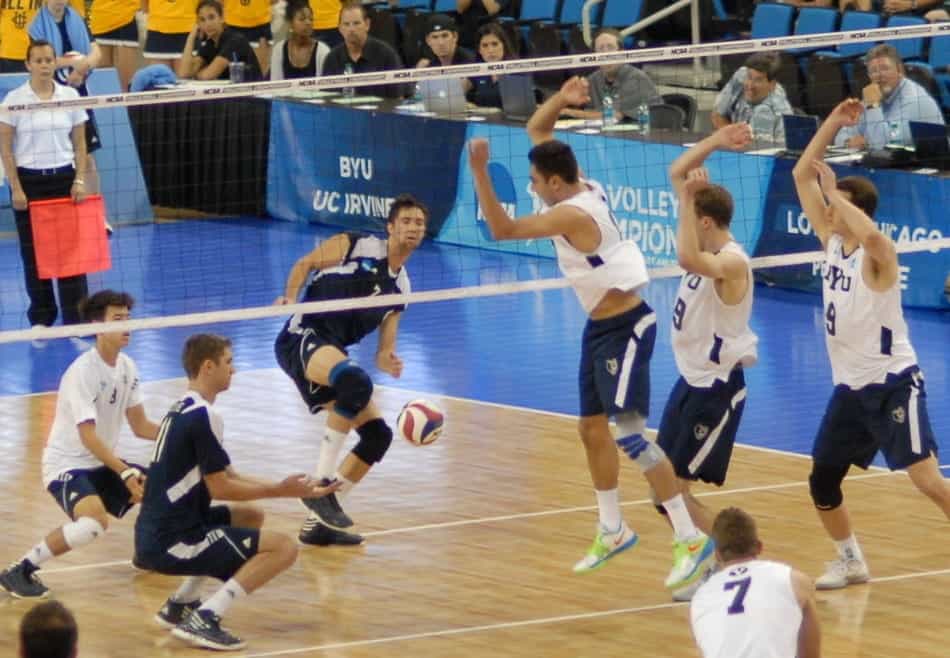Most people who have played volleyball have asked this question before and believe it or not, many people have been given the wrong answer! Keep reading to see if you know the right answer.
Can you actually kick the ball in volleyball? The answer is: it depends on which league you play in. According to USAV Rule 9.2 you can contact the ball with any part of your body. So playing at the highest levels, the answer is yes, it’s legal to kick the ball, even intentionally. However, in U.S. high schools and junior high schools, it is illegal to intentionally use any part of the body below the waist.
So if you’ve grown up in the U.S.A. school system, you’ve been taught that it is illegal to kick the ball. We are taught that the only contact that can happen with the ball with any body part below the waist is if our foot is planted and the ball bounces off of it. For much of the rest of the world, kicking the volleyball is completely legal and normal no matter what age or level they are playing at.
Why Would It Be Illegal To Kick The Ball In Lower Levels Of Volleyball?
This is a fair question: if Olympic and college players are able to kick the ball, why shouldn’t we all be allowed to? While it might sound like fun, there are some consequences to following that rule.
- When kicking, it’s very easy to either kick a teammate in the head or kick the ball into your teammate’s head at close range. While this might seem like a remote possibility, just consider your teammate diving for the ball and you going for a desperate kick. Fire up the ambulance, someone’s got a concussion.
- It’s a bad habit with poor results. When players are taught for years to avoid kicking they learn to pursue good quality hits even in desperate situations. If beginners are allowed to kick it becomes a hard habit to break and kicks are definitely poor form and offer inconsistent results.
- When you intentionally kick a volleyball, it’s easy to damage the ball. Volleyballs are made for high-speed impacts, but they are designed for impacts with the floor and arms, not really for kicking. You won’t damage the ball every time, but they aren’t made like a soccer ball either. If you kick a volleyball frequently it doesn’t take long to warp it, which makes it terrible to play with.
All of these are great reasons to choose not to kick in volleyball. I think it’s a great choice that the NFSHSA (National Federation of State High School Athletics) has kept this rule in place for the lower age groups. At higher levels of play, the players understand how pitiful the quality of their kicks will be. They know to only use it in dire circumstances and would be more aware to avoid kicking beside a diving teammate.
Volleyball Kicking Rules
If you are watching (or playing in) college or professional or Olympic level games, there are still a few rules to keep in mind that have to do with kicking the ball:

A Kick Counts As A Touch
The kick counts as a touch whether intentional or not. Many times the kick will come off of a block. The ball drops and the only way to keep it from hitting the ground is to kick it up.
That counts as a touch, so you and your teammates must treat it as such. You can’t make the next contact with the ball or it will be a double hit (two consecutive touches). Also, they don’t have 3 more hits to play the ball over the net.
Can I Kick Serve?
If I can kick the ball, then can I do a kick serve in volleyball? It is illegal to kick serve in volleyball no matter what league you play in. The reason is not in the rules for playing the ball, it’s in the serving rules. When serving, you have to make contact with a single hand. That specifically eliminates every other body part from the serve.
Can I Kick The Ball In Beach Volleyball?
You might be wondering, can I kick in beach volleyball too? The answer is yes, the rules are the same for beach volleyball as indoor when it comes to kicking.
Again you should consider some of the same factors. Kicking in beach volleyball will again be very inconsistent compared to good solid hits with your arms.

In most situations where you might think about kicking in beach
The main reason I wanted to share the information in this article was to share more in-depth knowledge about a commonly asked question that many of us have an incomplete answer about. When American players watch college and Olympic competition it can be confusing when there’s a difference in rules that we don’t understand.
Related Questions
What Is Kick Volleyball?
There is a sport played mainly in Asian countries called Sepak Takraw. I actually had the pleasure to play many times while visiting Thailand and it’s very fun. You play on a net that’s about 5’ high – the same height as a badminton net. The ball is much smaller and designed for kicking.
Originally the Takraw ball was made of reeds that were entwined to make a ball about the size of a small melon. Modern balls are made of hard synthetic plastic. The teams have 3 players each instead of 6.

Instead of playing mainly with your arms and hands, you use everything except your arms and hands! Players mainly use their feet but frequently use their shoulders, knees, and head as well. There are a few other rules, but that’s basically it.
If you would like to learn more about this sport, I wrote an in-depth post and even included a pretty cool video. You can find it in this post called: What Is Sepak Takraw?
Sidenote: Look for the debut of Sepak Takraw in the Summer Olympics, expected to come in 2024.
Can You Use Your Head In Volleyball?
Absolutely! In any league at any level you can use any part of your body above your waist. You probably will never use your head intentionally to hit the ball in a serious game, but it is legal.
Can A Server Step On The End Line?
The server must stay behind the end line (the backline that is the outer boundary of the court) until after the contact with the ball is made. If the player is performing a jump serve, they must not touch the line or any part of the court until after they have struck the ball, then they may land on the line or inside the court.
If the player’s foot touches the line in any way it is a foot fault and the referee will blow the whistle and award a point and the ball to the other team. If there are line judges, they are assigned to watch for foot faults and signal the ref if one is committed.
If you would like to learn more about serving rules, visit this article by clicking here.
Photo credits:
BYU image by KLM volleyball on flickr.com: https://creativecommons.org/licenses/by/2.0/
Sand kicking image by Renair Carvalho from Pixabay
Takraw player image by Mark Fischer on flickr.com: https://creativecommons.org/licenses/by-sa/2.0/, cropped for size.
Recent Posts
Athletes, listen up! Do you have a closet full of old jerseys, sweatpants, and tees that you just can't seem to part with? Well, dust them off, because you're sitting on a goldmine of fashion...
You may have heard, or you may have noticed, that there's been a change to the rule about double contact in volleyball. In 2022, an experimental rule change began to be implemented, where the double...
